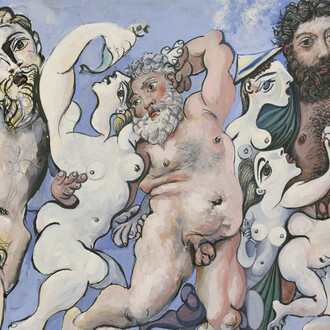Avelino Sala's works address the inequality and dystopia associated with colonialism and war, which are very much present in a dystopian present where the war industry is once again taking precedence over social needs. As part of Barcelona Gallery Weekend, ADN Galeria presents These machines kill fascism, the artist's third solo exhibition at the gallery. The exhibition will be open to the public from Thursday, September 18 at 12 pm, and will count with a guided visit by the artist at 7 pm.
Sometime in 1941, as World War II intensified, Woody Guthrie scribbled “This machine kills fascists” on his acoustic guitar. The humorous -yet also quite serious- slogan of the folk singer and left-wing political activist has become iconic. With this motto, Sala's works compete with a diverse legacy of modern and romantic theories while inviting us to an aesthetic reception that places us differently in the world and makes us more reflective about the future of humanity.
Among the pieces that make up this exhibition there’s Estrella de cinco puntas (UN security service) (2025). The piece consists of the five flags of the five permanent members of the United Nations Security Council (China, France, Russia, the United Kingdom, and the United States). These members have veto power, which means they can block any Security Council resolution. The practice of placing a flag on a coffin is common in many funeral rites, especially for military personnel, veterans, or members of certain organizations. In this custom, which follows a specific protocol, the flag symbolizes the service and dedication of the deceased.
This is followed by a video piece in which silence and metaphor take shape. Entitled 4' 33" minutos de silencio de minutos de silencio (2020), this triptych is inspired by John Cage's three-movement musical work 4'33” (1952). While interpretations of Cage's score emphasize ambient sounds, the silent video records images of politicians, drivers, athletes, and spectators standing in mass silence to honor those who have died in accidents, terrorism, or natural disasters. Here, Sala appropriates television images from various channels around the world to create a metalanguage of minutes of silence with minutes of silence, without wasting the ambivalence and triggers that the idea of the absurd can also activate.
In the series Mirror stage (2024-2025), the artist confronts Goyaesque images from the series Los desastres and Los disparates de la guerra with images taken from the current press coverage of contemporary armed conflicts. Sala proposes the idea of looking in a mirror at the very condition of existence and its anguish, in the manner of Lacan.And on the other hand, confronting art history with current reality, scanning our time through the eyes of Goya. Once again, the intertwining of historical periods and memories of art struggles in a setting that competes with its aesthetic and political dimensions with unprecedented emotions and amazement. “Feathers are something that has no value, no weight, something that is carried away by the wind, which presents itself as a light and ethereal metaphor.” A metaphor that explicitly shows how the dramas of war from centuries ago are repeated in the migration crisis or the extermination in Gaza, as the author himself explains, giving the work a halo of relevance.
Based on slogans from the fight against climate change and works of art history that deal with landscape, Sala attempts to capture environmental collapse from a perspective that unifies aesthetics and critical discourse in Guernica/Fridays for future (2025). This project reflects on the history and struggle between humanity and nature that has led us to the current critical moment. These texts and images captured on sections of tree trunks function as a kind of memory map that tells us what has happened at a specific time. A section of a tree that is more archaeology of the present than dendrochronology.
In L'uomo delinquente (2025), Sala reveals, on an old porcelain head, the division that supported phrenology—a pseudoscience developed by Franz Joseph Gall in the 19th century. This division would show specific “organs” or areas that controlled different mental faculties, and the shape of these areas, reflected in the skull, indicated the development and strength of those faculties. The sculpture is accompanied by books gilded with gold leaf, in which concepts and attributes associated with behavior can be read, such as a dangerous sublimation of the emotional and moral dispositions that almost portray—from a biopolitical point of view—the subject who will have to make his way through the 20th and 21st centuries.
The exhibition is rounded off with pieces such as the Ecotopia (2025) series of watercolors, the message in a bottle thrown into the void in Socorro (2025), and the globe of Naturaleza muerta (2025). Sala makes a contemporary comparison to refer to the crisis of a predatory capitalist model and the supposed instrumental rationality that underpins it, as well as the rise of the insignificant in the political and cultural spheres. The aesthetic system of art, with its paradoxes and ambivalences, leaves a range of questions and associations of meaning that each person can reconstruct based on their own experience and education.













![Saul Steinberg, The museum [El museo] (detalle), 1972. Cortesía del Museo de Arte Abstracto Español](http://media.meer.com/attachments/dfbad16c22c5940b5ce7463468ac8879f3b4bf23/store/fill/330/330/042ecf3bcd2c9b4db7ddbc57cb32e950c095835f7b5cd55b6e1576a6e78c/Saul-Steinberg-The-museum-El-museo-detalle-1972-Cortesia-del-Museo-de-Arte-Abstracto-Espanol.jpg)


